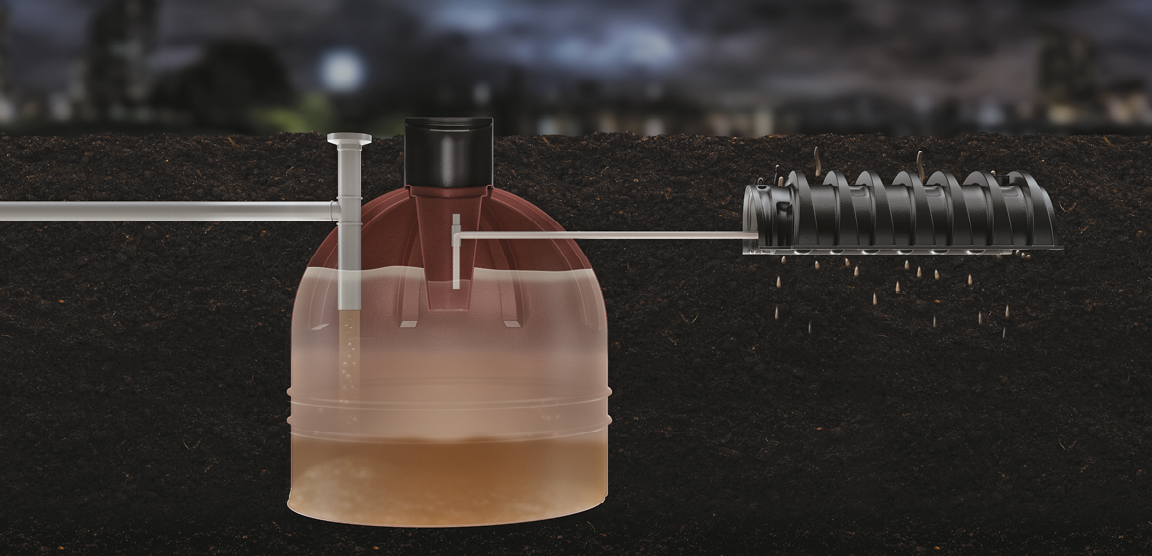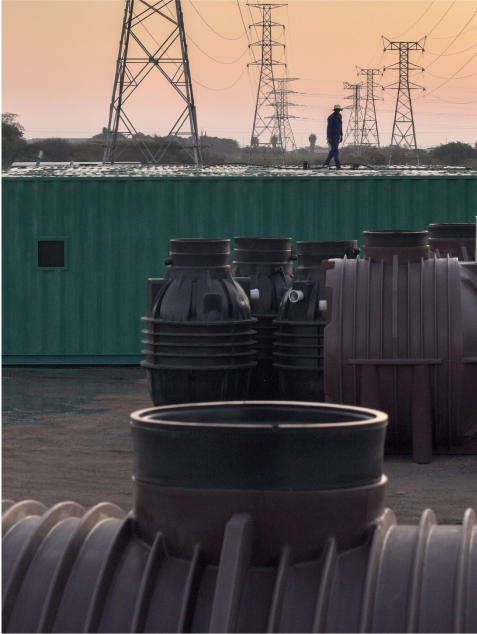At Calcamite, we regard ourselves as responsible stewards of our environment, so we know that it’s vital to consider the various factors that influence the operation of septic tank systems. Septic systems are essential for treating wastewater in areas where centralised sewerage systems are not available.
If properly installed, used and maintained, our SABS-certified septic tanks provide effective long-term wastewater treatment. That said, it’s crucial to ensure that they are installed and managed in a way that minimises their environmental impact.
At Calcamite, we understand septic tank environmental impact as well as how to ensure their optimal operation. We know what type of soil is good for septic tanks and what other factors impact their installation, performance and maintenance.
Additionally, we know how to best place these systems in order to avoid installing septic tanks in a high water table as this is crucial for their efficient functioning and sustainability. And for all you keen gardeners out there, we even know how to properly landscape around septic tanks!
In this blog post, we’ll highlight the key considerations for environmentally-friendly septic tank operation. We’ll explore the best septic tank soil types, the impact of the water table, optimal locations, and the role of landscape topography. We’ll also discuss the role of advanced features like aeration tiles and infiltration chambers in a septic system.
Environmental Considerations for Septic Tanks
Soil Type
One of the key aspects to consider in deciding on your septic tank’s location, is the type of soil where it’s to be installed. The three primary types of soil are clay, sand, and silt, and each type influences how your septic system functions.
- Clay
Clay soils have tiny, compact particles that hinder the passage of wastewater, potentially leading to system backups. If your septic tank soil type is predominantly clay, you might need additional interventions to ensure proper drainage.
- Sand
On the other end of the spectrum, sandy soils have large, coarse particles that allow water to pass through too quickly, potentially leading to insufficient treatment of the wastewater. Therefore, whilst sand might seem like a good soil type for septic tanks, it often requires adjustment to ensure the effluent is adequately treated.
- Silt/Loam
Silt, with particle sizes between sand and clay, provides a good soil type for septic tanks. However, the specific properties of the silt, such as its density and composition, can vary widely and will need to be evaluated carefully.
Therefore, regardless of your soil type, a percolation is always indicated to assess how quickly water moves through the soil. This test is critical as it helps to determine the size of the drain field that your septic system will need.
The health of the your soil’s microbiome is also very important. This is indicated by the soil’s pH, and it can significantly affect bacteria growth. These bacteria play a crucial role in breaking down the waste in your septic system.
Water Table
Understanding your septic tank water table is crucial. The water table is the level below which the ground is saturated with water. If you’re considering installing a septic tank where there’s a high water table, you run a high risk of groundwater contamination.
If the water table is too close to your septic tank or its drain field, you could have untreated effluent escaping into the groundwater, which is not environmentally sound.
A high water table can also influence the installation and performance of your septic system. This is why we always do a thorough site evaluation to ensure a safe vertical separation distance between your septic system and the water table is maintained.
Location
Apart from the water table, other location considerations are important when installing a septic system. These include proximity to other water bodies, buildings, property lines, and utility lines. You need to ensure that your septic tank is not too close to drinking water wells, streams, lakes, or wetlands to prevent possible contamination.
The best location for a septic tank is in a well-drained area with enough space for the system to function well, and for potential repairs or expansion. It’s also important to avoid areas that are subject to heavy traffic or construction, which could cause damage to the system. Any landscaping over a septic tank also has to be done very carefully.
Landscape Topography
The ‘lay of the land’ or topography can significantly impact the installation and function of a septic system. Typically, septic tanks should be installed in level areas so that solids can settle properly in the septic tank.
A slope may either positively or negatively affect the installation and drainage of a septic system. In certain cases, landscaping techniques may have to be used to create a suitable environment for the septic system.
And we need to repeat that it’s crucial to remember that landscaping around septic tanks has to be done extremely carefully to prevent damage to the system or interfere with its function.
Aeration Tiles
Aeration tiles play a crucial role in efficient and environmentally-friendly septic systems. They contribute significantly to the breakdown of wastewater by increasing oxygen levels, which in turn enhance the activity of aerobic bacteria.
These bacteria are indispensable players in the decomposition of organic matter present in the wastewater, and transforming it into safer by-products.
By enhancing the bacterial breakdown of waste, aeration also leads to a higher quality of effluent. This reduces the septic tank’s environmental impact by lowering the risk of groundwater contamination.
Furthermore, the effective use of aeration tiles can reduce the size of the drainage field required. This’ll save you money and make the installation of septic systems more viable on properties where space is an issue.
However, the effectiveness of aeration tiles relies heavily on their correct placement. It’s crucial to ensure they’re not installed in a location where they could release harmful gases into occupied areas or near air-intake units for buildings.
At Calcamite, we have the expertise to assess your site’s specific conditions and establish the best placement for aeration tiles in your septic system. Our experienced team can design an efficient and sustainable septic system that’ll minimise the environmental impact of your septic system and will comply with all regulations.
In the next section, we’ll take a close look at infiltration chambers – a modern innovation that makes septic systems more efficient and adaptable to varying site conditions.
Infiltration Chambers
The use of an infiltration chamber is an increasingly popular component in septic system designs. Infiltrator chamber septic systems provide an excellent solution for managing wastewater, particularly when traditional septic systems may not be possible because of factors such as a high groundwater table or limited space.
In essence, our cost-effective infiltration chambers are hollow structures that temporarily hold the effluent from a septic tank. These chambers, often made from sturdy plastic, are designed to maximise the infiltrative surface area.
This not only improves the effluent dispersal, but also raises the system’s overall performance by promoting the growth of bacteria. These chambers also offer considerable storage capacity, thus enhancing your system’s ability to cope with larger and variable influent volumes.
One of the key advantages of our unique concave-shaped infiltration chambers is their ease of installation. They are strong but lightweight, which reduces labour costs and installation time compared to traditional stone and pipe systems. Additionally, the chambers’ design flexibility allows for adaptability to a range of site conditions. They eliminate the need to use construction aggregate and also require less space.
However, for infiltration chambers to function effectively, the soil type in the area surrounding the chambers is of utmost importance. Remember our earlier discussion on the soil types suitable for septic systems? The same principles apply here. For instance, sandy and loamy soil types are ideal. Due to their good permeability and improved filtration capabilities, these soil types offer optimal conditions for wastewater treatment.
At Calcamite, we recognise the importance of a properly designed and installed septic system. We leverage our extensive expertise to assess your specific site conditions to determine the suitability of infiltration chambers for your property. We’ll also ensure that your entire septic system meets the highest standards of environmental sustainability and efficiency.
Conclusion
At Calcamite, we know that setting up an efficient, environmentally friendly septic tank system isn’t a one-size-fits-all process. We know it requires a thorough understanding and careful consideration of numerous factors:
- The type of soil on your property
- The level of the water table
- The location of other features like wells, streams, boreholes or utilities
- The best location for your septic tank installation
- The selection and implementation of systems components such as aeration tiles and infiltration chambers to enhance efficiency.
Each of these elements plays a crucial role in ensuring the best location for your septic tank, its longevity, effectiveness, and minimal environmental impact. Whether it’s the septic tank’s environmental impact, the role of the different soil types, the significance of the water table, the importance of location, or the advantages of using infiltration chambers, our clear understanding of all these dynamics will help you maintain an eco-friendly septic system.
Calcamite has been in business since 1967. We’re eminently qualified to help you navigate the complexities and potential pitfalls of installing and managing a septic system. We offer our clients a full turnkey solution as regards the design, installation and maintenance of any septic system. Our team of experts can assist you every step of the way – from site evaluation, system design, product selection, to ongoing maintenance, support and septic tank landscaping.
So, if you’re considering a new septic system, planning an upgrade, or just have a few questions, we can help you. We’ll guide you through every step of the process, whether its assessing your soil type, helping you install a septic tank near a water table, or just landscaping around your septic tank.
We can advise you about choosing between different system components like aeration tiles and infiltration chambers. Our specialists can help you make the most of your septic system, ensuring it operates efficiently, safely, and with minimal environmental impact. Contact us – we’re there for you!



